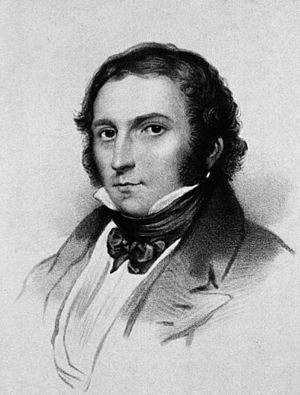Charles Orpen facts for kids
Quick facts for kids
Dr.
Charles Edward Herbert Orpen
|
|
|---|---|
 |
|
| Born | 31 October 1791 Cork, Ireland
|
| Died | 20 April 1856 Port Elizabeth, South Africa
|
| Nationality | Irish |
| Occupation | Doctor |
| Known for | Founder of the Cleremont Institution for the Deaf and Dumb |
Dr. Charles Edward Herbert Orpen (born October 31, 1791 – died April 1856) was an important Irish doctor, writer, and church leader. He is best known for starting the Claremont Institution in Dublin. This was a special school for children who were deaf and couldn't speak.
Contents
Who Was Charles Orpen?
Charles Orpen was born in Cork, Ireland. He was the youngest of three sons. His family lived in Dungourney for some years. His father was a vicar, which is a type of church leader.
Early Life and Education
After his father passed away, Charles decided to become a doctor. He started learning with Dr. Gibbings in Cork. However, when he tried to take his exams in Dublin, he found out his training wasn't valid. This was because Dr. Gibbings wasn't officially approved by the college.
So, Charles had to start a second five-year training period. He learned with Surgeon Todd in Dublin. After this, he was finally able to take and pass his medical exams.
Helping Deaf Children
In 1816, Dr. Orpen was working at a place called the House of Industry in Dublin. This was like a large workhouse that helped poor people. There, he found at least 21 children who were deaf.
He chose a 10-year-old deaf boy named Thomas Collins. Dr. Orpen decided to teach Thomas himself at his own home.
The First Student: Thomas Collins
The next year, Dr. Orpen showed Thomas Collins's progress to the public. This happened at a special event in Dublin. Thomas had learned to write, do math, and even speak a little. This was after only a few months of lessons.
People were very impressed by Thomas's progress. They quickly decided to support the cause of educating deaf children.
Starting a School
Soon after, a group called the National Institution for Education of the Deaf and Dumb Poor in Ireland was formed. This group rented two rooms in Dublin. Here, they could teach and house a small number of deaf boys.
It was hard to find qualified teachers for the boys. Dr. Orpen and his friends spent a lot of time finding the right teaching methods. They also supported the teachers. Dr. Orpen believed in using the manual method, which uses hand signs.
In 1817, the group rented a bigger house. It was on Brunswick Street (now Pearse Street). This new place had enough room to teach 16 students.
The Claremont Institution
News of Dr. Orpen's work spread quickly. Many wealthy parents wanted their deaf children to get an education too. The committee asked the public for money to help.
In 1819, they bought a large property called Claremont. It had a house near the village of Glasnevin, just outside Dublin. This became the new home for the school. Around this time, girls were also allowed to attend the school for the first time.
Caring for the Poor
In 1818, Dr. Orpen became a medical inspector. This meant he visited the homes of thousands of poor people in Dublin. This was during a time when many people were sick with fever.
He was shocked by how people lived. He criticized landlords for the dirty and unhealthy conditions of their properties. Later, he wrote a pamphlet about his experiences. It was called An Address to the Public on the State of the Poor in Dublin.
Later Life and Legacy
Dr. Orpen knew the Irish language well. He was also a very religious person. He supported efforts to share religious texts in Irish across the country. He wrote some short articles for a society that promoted this.
In 1823, Dr. Orpen married Alicia Frances Coane. They had nine children together. In 1848, the family moved to South Africa. There, Dr. Orpen became a pastor, which is another type of church leader.
He set up a home for old and sick former slaves. He also spoke out against how British and Dutch settlers treated the native people. Dr. Orpen passed away in Port Elizabeth, South Africa, in 1856. Several of his sons later held important government jobs in South Africa.
Images for kids


